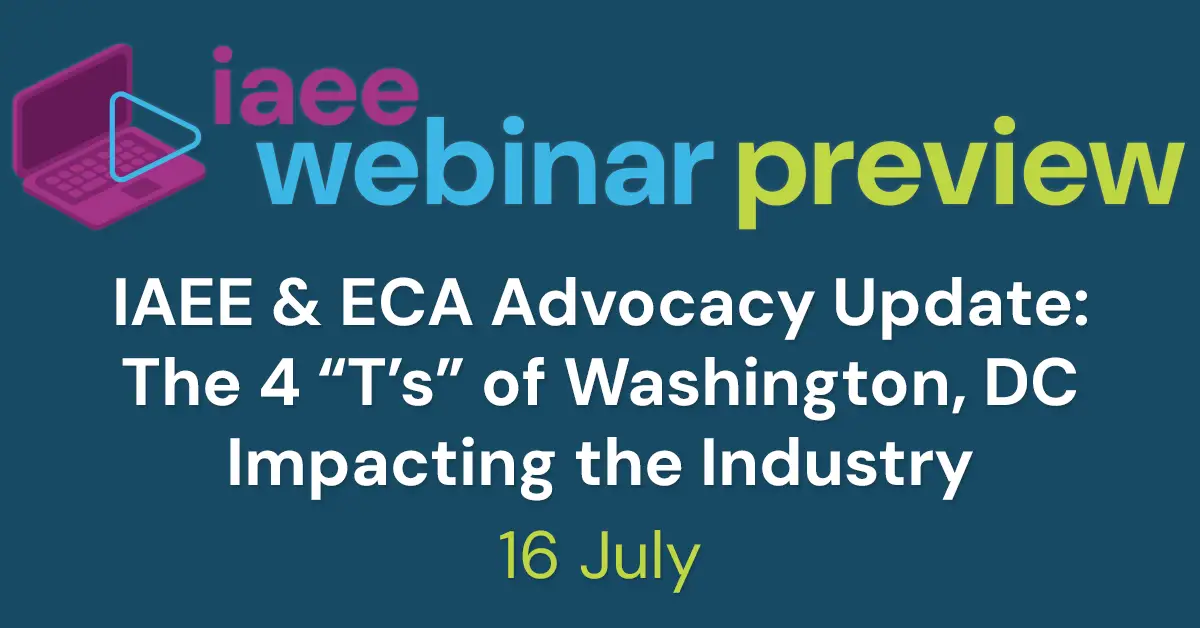By Mary Tucker | Senior Communications and Content Manager | IAEE
The exhibitions and events industry operates in an increasingly complex regulatory environment, where policy decisions made in Washington, D.C. can have far-reaching impacts on everything from international participation to workforce development. As legislative priorities shift and new regulations emerge, industry professionals need to stay ahead of the curve to protect their businesses and maximize opportunities.
This past May, 170 business and professional events industry leaders and advocates from 30 states met with their elected officials on Capitol Hill as part of the Exhibitions and Conference’s (ECA) annual Legislative Action Day – a record showing!
In the upcoming IAEE webinar, IAEE & ECA Advocacy Update: The 4 “T’s” of Washington, DC Impacting the Industry, ECA Executive Vice President Tommy Goodwin will discuss the critical policy issues currently shaping our industry. Tommy will break down what he calls the “4 T’s” of Washington advocacy – tariffs, travel, taxes and talent – and explain how each area directly affects exhibition organizers, venues and service providers across the country.
Whether you are navigating international exhibitor relationships, planning budgets amid changing tax policies or struggling with workforce challenges, understanding these policy dynamics is essential for strategic planning. Read on for insights from our conversation with Tommy, then join us for the full webinar to dive deeper into these critical advocacy issues.
Tommy, you’ve identified tariffs, travel, taxes, and talent as the “4 T’s” impacting our industry. Can you explain why these four areas have become the primary focus of ECA’s advocacy efforts in Washington?
Tommy: ECA’s advocacy focus is determined by IAEE and our other association alliance partners. IAEE President and CEO Marsha Flanagan, M.Ed., CEM does an incredible job keeping her finger on the pulse of what IAEE members are experiencing on the show floor and passing that information along to ECA in Washington, D.C.
Through that process, the industry has made clear that the “4 T’s” – tariffs, travel, taxes, and talent – have an outsized impact, both in the near term and in the longer term. This is why ECA has prioritized these important issues in our work on Capitol Hill and with the White House.
Let’s start with tariffs. How are current trade policies affecting exhibition organizers and their international exhibitors? What specific challenges are you hearing about from industry members?
Tommy: The new tariffs introduced since 20 January have led to significant concern within the industry. Why? Because they have increased costs for event organizers, exhibitors, attendees, and service providers alike. They are also particularly harmful to small businesses, which account for 99% of our industry’s companies and 80% of all exhibitors.
That’s why ECA is working with our member associations, coalition partners, and other key stakeholders in Washington, D.C. to oppose these new tariffs and advocate for trade policies that will strengthen the competitiveness of the industry going forward and allow us to continue to serve as a growth engine for the U.S. economy.
Travel policies have been an ongoing concern, especially post-pandemic. What are the current visa and immigration issues that are making it difficult for international attendees and exhibitors to participate in U.S. trade shows?
Tommy: Since post-pandemic international travel, our industry has been challenged bringing back all its international exhibitors and attendees from around the world. Last year, ECA helped the U.S. State Department secure $50 million for visa backlogs, which helped bring visa wait times down at many U.S. embassies and consulates around the world. That said, there is still more to be done. Currently, 51 U.S. posts have visa interview wait times of more than 3 months.
In addition, last month the Trump administration introduced full or partial travel restrictions of citizens of 19 countries. Last year, these countries contributed 336,355 of the 72,390,321 international visitors to the U.S. in 2024, or 0.46%.
On the tax front, what recent or proposed changes should exhibition professionals be most concerned about? Are there specific tax policies that could significantly impact event budgets or venue operations?
Tommy: ECA has been working overtime to ensure that the industry is positively impacted by tax reform in Washington, D.C. ECA has been lobbying tirelessly to encourage Congress to take up and pass federal tax legislation that is pro-growth, pro-investment, pro-impact, and pro-workforce development, which they are on the cusp of doing with the “One Big Beautiful Bill.”
What does that mean? Congress will maintain a competitive business tax rate, the current treatment of private investment capital, and the nonprofit status of associations and their events. This is good news for the industry and will help us continue to drive economic growth, support job creation, and empower small businesses.
The talent shortage seems to be affecting every industry right now. What unique workforce challenges is the exhibitions industry facing, and how is ECA working to address these issues at the federal level?
Tommy: In 2020, 2.8 million industry workers were furloughed or laid off during the pandemic. Only 2.5 million of them came back. Since then, the industry has been working tirelessly to recruit and train our next generation skilled workforce, but we need help from Washington, D.C. to expand the pool of Americans with the skills and training necessary to have great careers in our industry.
ECA has been advocating for two proposals on Capitol Hill that would expand Pell Grants to cover skilled workforce training and expand 529 programs to cover industry certifications like IAEE’s CEM Learning Program. Both provisions are currently included in the “One Big Beautiful Bill,” and ECA anticipates that they will be signed into law soon.
Looking ahead, which of these “4 T’s” do you think will have the most significant impact on the industry in the coming year? What should IAEE members be preparing for, and how can they get involved in advocacy efforts?
Tommy: In the near term, tariffs. Over time, Congress has delegated most trade and tariff policy decisions to the executive branch, so President Trump has near unilateral decision-making authority when it comes to tariffs.
That’s why ECA encourages industry leaders and advocates to share their concerns with policymakers through the ECA Advocacy Network’s email action center. In addition, ECA has also established the ECA Tariff Resource Center on the ECA website with the latest trade and tariff policy news impacting the industry.


